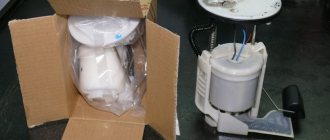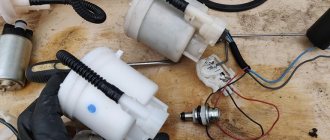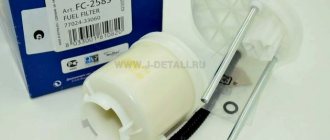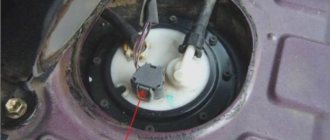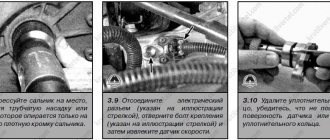Toyota Corolla is the leader in sales among cars all over the world. It is for this reason that she was included in the Guinness Book of Records. Its fundamental nature, ease of operation, and impressive characteristics brought it such demand.
Corolla 120 sedan
Cars of this brand are considered among the most durable in the world and rightfully top numerous reliability ratings. But despite all these aspects, this car requires timely maintenance. In our article we will conduct a detailed analysis of an important part of this process - replacing the fuel filter for Toyota Corolla 120 and 150 bodies.
How to determine a faulty fuel pump
In order to determine a malfunction in the fuel pump, a special device is required that measures the pressure that is created in the fuel line. Measurements are carried out in three options:
- without turning on the engine;
- idling;
- 5 minutes after stopping the engine.
If the pressure in the fuel line within 5 minutes after stopping the engine becomes less than 1.5 kgf/cm2, and while the engine is running at idle speed the instrument reading is less than 3.1 kgf/cm2 or exceeds 3.5 kgf/cm2, then replace fuel pump in Toyota Corolla is the only right solution.
Causes of malfunction
You can suspect a malfunction of the fuel pump of a Corolla 120 or 150 body based on the following characteristic signs:
- A decrease in engine power, which occurs due to wear of the fuel pump and requires its replacement.
- The engine does not start well even after proper warming up. This occurs due to the wear and tear of the valve that maintains the pressure in the system at the required level, or the gas tank mesh may be dirty, which can be removed and cleaned or simply replaced.
- Jerky movement can also be caused by both wear of the pump elements and third-party contamination.
- The engine often stalls and stalls.
- Extraneous noises during engine operation.
The presence of these malfunctions is a reason to seek help from a service station to receive qualified assistance, which usually begins with diagnostics (high-quality diagnostics are carried out using Bosch equipment). Most often, when the components wear out, the fuel pump is replaced, as well as consumables that ensure its uninterrupted operation.
Other causes of fuel pump malfunction include:
- Low quality fuel, as well as the presence of impurities, dust and water in it.
- Accumulation of condensate in the gas tank due to temperature changes.
- The habit of driving with a tank less than half full of gasoline.
- Dirty fuel filters.
You can choose the right fuel pump if you know exactly the make and model of the engine.
Symptoms of a problem
The fuel pump in most Toyota cars equipped with gasoline engines is installed in the fuel tank. A clear sign of its malfunction is the lack of gasoline in the combustion chamber, as a result of which the car does not start.
Occasionally, the pump may shut down or reduce its performance. As a result, the pressure in the fuel rail becomes lower than normal. In this case, it is difficult to accurately diagnose the fault. It is impossible to do without special measuring instruments.
Signs of a fuel pump malfunction are as follows:
- jerking may occur when moving;
- the engine idle speed begins to “float”;
- the power unit starts poorly at any ambient temperature.
Rules for removal and replacement
It is necessary to remove the fuel pump in models with a body size 120 and above after first removing the rear seat. It is under it that there is a hatch for the gas tank, under which you can find the fuel module along with the fuel line. There is also a power supply connector for the fuel system.
Dismantling the fuel module must be done very carefully to prevent damage to the plastic housing and fasteners. The module is removed after being completely disconnected from the fuel line and disconnected from the electrical connector.
Quite often, the cause of incorrect operation of the fuel pump can be a clogged mesh of both the coarse filter and the fine filter. This involves replacing the pump and all filters included with it.
Before installing the fuel pump for Toyota Corolla 12 and above, it should be checked on a diagnostic stand along with the entire complex involved in supplying fuel to the engine.
After the verification procedure, the module is installed and connected to the mains. It is necessary to monitor the quality of installation of sealing elements - sealing rings and gaskets, which are responsible for the penetration of excess air into the system. After this, the rear seat is installed in place. Timely diagnostics, high-quality maintenance and proper operation are the key to efficient operation of not only the fuel pump, but also all vehicle systems as a whole.
Replacement procedure
If the fuel filter has not been replaced and the mileage exceeds more than 100 thousand km, then you may not know how to replace the fuel pump on a Toyota Corolla. In this case, all elements (pump and filter) are combined into one unit. To replace, you need to purchase a fuel pump. If necessary, use a fuel filter. The operating procedure is as follows.
- Disconnect the negative terminal of the battery.
- Remove the lower part of the rear seat.
- Open the cover that prevents access to the gas tank.
Before disconnecting the fuel lines and removing the cap, prevent dust from getting inside the gas tank. The cap unscrews in a counterclockwise direction. - Remove the assembly.
- Unclip the bottom by removing the plastic clips holding the bottom in place.
- Remove the fuel pump along with the L-shaped filter.
Depending on the generation of the car, the components in which the fuel pump is installed may differ. So, in the Corolla 150 the unit consists of two components, and in the 120 version it is combined into one. When dismantling, focus on the coarse fuel filter, which has an L-shape.
The fuel pump holds nothing inside the plastic container except a rubber gasket. Don’t forget to install it in its place with the new part.
One of the reasons why a Toyota Corolla fuel pump may need to be replaced is a clogged filter element. Avoid operating the car with a minimum level of gasoline in the tank, since the fuel pump is cooled through fuel circulation.
Features of work
The fuel pump in the Toyota Corolla, which is found on most models with a 120, 140 and 150 body, works on this principle: at a given point in time, a fuel-air mixture is injected in certain proportions and volumes into the engine. This happens through the injector nozzles. The combustion of the mixture occurs after ignition by a spark from the candles.
Unlike carburetor engines, which were no longer installed on the Corolla since 1998, there is a saving in fuel consumption and an increase in traction power by 10%. It also ensures maximum reduction of harmful substances in exhaust gases entering the atmosphere.
An injection engine requires a more careful approach (such units are installed on Toyota Corolla models 120 and 150) both in maintenance and repair. Therefore, replacing the fuel pump and carrying out repair work, its removal and installation, if possible, should be carried out at a service center.
In addition to ensuring the supply of fuel to the engine, the pump regulates the required optimal pressure level in the fuel supply system.
content .. 27 28 29 30 ..Toyota Corolla E150 (2010+). Fuel pump malfunction (does not pump gasoline)
One of the most important elements of the fuel injection system of a gasoline engine is the electric fuel pump, which is located in the fuel tank of the car. The fuel pump pumps fuel into the system from the gas tank, creating a certain pressure.
Auto repair experts identify the following common fuel system problems that are related to the fuel pump:
The fuel pump pumps poorly and does not create the required pressure; the fuel pump does not pump when the ignition is turned on; Considering that the fuel pump is an electromechanical device, the most common fuel pump malfunctions are related to both the mechanical and electrical parts. Next, we will look at what signs indicate a breakdown of the fuel pump and why the fuel pump stops pumping partially or completely.
Signs of fuel pump malfunctions
The main symptoms of fuel pump failure, as well as malfunctions in its operation, are:
the car starts with difficulty, the engine runs unstable, there are dips, jerking when pressing the gas pedal, etc.; the pump does not pump after turning on the ignition, does not turn the starter and does not pump the fuel pump, the engine does not start; There have also been cases when the fuel pump stops pumping while driving. In such a situation, the engine begins to malfunction and stalls immediately after the remaining gasoline in the fuel line is used up. The problem can occur either regularly or periodically.
The fuel pump does not pump: causes and diagnostics
Let's start with the fact that if the gas tank is full, the battery is charged, the spark plugs are dry and there is a spark, the starter turns the engine normally, but the engine does not seize, then you should pay attention to the gas pump. A common problem is that there is no power to the fuel pump after the ignition is turned on. In a similar way, the malfunction manifests itself in motion, when the power to the fuel pump is lost and the engine suddenly stalls.
An equally important point is how much the fuel pump pumps. In other words, the pump may hum and buzz (power is being supplied), but not create the required pressure in the fuel line. The pressure in the fuel system with a working fuel pump must be more than 3 bar (which depends on the specific car model). The indicated pressure is accumulated in the fuel rail and has an indicator of 300 kPa and above.
To check, you need to measure the pressure in the fuel rail with a pressure gauge, taking into account the indicators that are the norm for a specific car model. Using the example of injection engines, the pressure when the ignition is turned on is 3 atmospheres, at idle the indicator is 2.5 atmospheres, when pressing the gas 2.5-3 atmospheres. This method will help you accurately determine:
malfunction of the fuel pressure regulator in the rail; breakdown of the fuel pump or a noticeable decrease in its performance due to wear; severe contamination of filters (fuel filter and/or fuel pump mesh); In the second case, when you press the gas, the pressure does not increase; in the latter case, the pressure gauge needle rises, but very slowly or jerkily.
A decrease in pressure below the norm will lead to the fact that the engine may not start or start with difficulty, stall, jerk, operate unstably and with failures. If this happens due to the fault of the pump and not the fuel filter, then there is a high probability that the coarse filter screen of the fuel pump is clogged. In this case, there is no need to change the fuel pump itself, since it will be enough to replace or even clean the mesh.
If you suspect that there is no voltage to the fuel pump, there is a quick way to check. It is enough to turn the ignition key and listen, as when you turn the key you should hear a slight hum from the fuel pump. If such a buzzing noise is not heard, it means there is no power to the fuel pump, there are problems with the wiring, etc.
We add that this method of determining the operation of the pump by sound is not suitable for all cars. On some models (especially premium ones), sound insulation is at a high level and the fuel pump turns on immediately after opening the driver's door, and not when turning the key in the lock. In this case, it may seem that the fuel pump does not work when the ignition is turned on, and the sound of the pump may simply not be heard. Also in the general list of possible reasons why the fuel pump does not pump, the following are noted:
- failure of the fuel pump fuse; - breakdown of the fuel pump relay; - problems with the ground of the fuel pump; - malfunction of the electric motor of the fuel pump; - oxidation or damage to the contacts and terminals of the fuel pump; - the fuel pump itself is faulty;
Wiring to the fuel pump
On most cars, the wiring to the fuel pump consists of three wires: “plus”, “minus”, and also a wire for indicating the amount of fuel in the gas tank. If the fuel pump does not pump, then the cause may be a lack of power.
To check the power to the fuel pump, just take a 12-volt light bulb and supply it with power from the external connector of the fuel pump. After turning the ignition, the control lamp should light up. If this does not happen, then the problem is in the external circuits. If the lamp comes on, it will indicate the need to check the internal contacts of the fuel pump.
To check the external wiring, you should alternately connect the positive and negative contacts, which are removed from the fuel pump power connector, to the ground of the pump. The contacts must also be connected to the fuel pump relay. If you place the negative contact on ground, after which the ignition is turned on and the light comes on, then this means that this contact is faulty. If the light bulb does not light up, then problems with the “plus” are obvious. If you place a contact on the relay and the light comes on, there is probably damage to the wire on the section that connects the relay and the fuel pump itself.
Fuel pump electric motor
If checking the pressure in the fuel rail and the external wiring to the fuel pump gives positive results, then you should check the fuel pump motor. This electric motor is responsible for circulating gasoline inside the fuel pump.
When checking, you need to take into account that the terminals on the fuel pump themselves tend to oxidize, as a result of which power is not supplied and the pump does not pump. In this case, the motor is working, but the terminals need to be cleaned or re-soldered.
To check the fuel pump motor, you will need to attach the test lamp wires to a cleaned and serviceable terminal of the electric motor, after which you should turn on the ignition. If the light comes on, this will indicate that the fuel pump motor is not working.
Fuel pump ground contact
Problems with the fuel pump mass may be indicated by a fuel level sensor that is not working correctly. The mass may be poorly secured; in this case, the fuel pump does not pump fuel. The ground wire is usually located under the dashboard and runs through the cabin. It is necessary to find the specified wire, check and clean all contacts, then securely fasten the ground to the fuel pump.
Fuel pump relay
The fuel pump relay is often mounted next to the fuel pump ground, that is, under the dashboard. A normally operating relay after turning on the ignition for a couple of seconds allows the pump to create pressure in the system and immediately turns off.
When the ignition key is turned, the driver hears a characteristic click (the relay is turned on), then a similar click will indicate that the fuel pump relay is turned off. If such clicks are not heard, this indicates a malfunction of the relay or its contacts. The optimal solution would be to replace the fuel pump relay with a new or known-good device. Let us add that the cost of spare parts is quite affordable.
Fuel pump fuse
During diagnostics, be sure to check the fuel pump fuse. The specified 15 A fuse is usually located in the fuse box in the engine compartment and is marked FUEL PUMP, which means fuel pump.
The fuel pump fuse needs to be pulled out and its contact inspected. The integrity of the contact will indicate that the device is normal. A damaged contact will indicate that the fuel pump fuse has blown. In this case, you need to install a new fuse, which has a very low cost (as in the situation with the fuel pump relay).
Other causes of fuel pump malfunctions
Quite often, unprofessional installation of additional electrical equipment or security anti-theft systems leads to the fact that the power to the fuel pump is lost due to mixed up contacts or other connection errors.
Also, one should not exclude the possibility that a malfunction occurred in the car alarm or security system, after which the power supply to the fuel pump is blocked. In other words, the alarm blocks the engine from starting. Finally, let’s add that the gas pump in the gas tank is immersed in gasoline, in which it is actively cooled. The habit of driving with an empty tank can quickly damage the electric motor of the fuel pump, as it burns out.
content .. 27 28 29 30 ..


